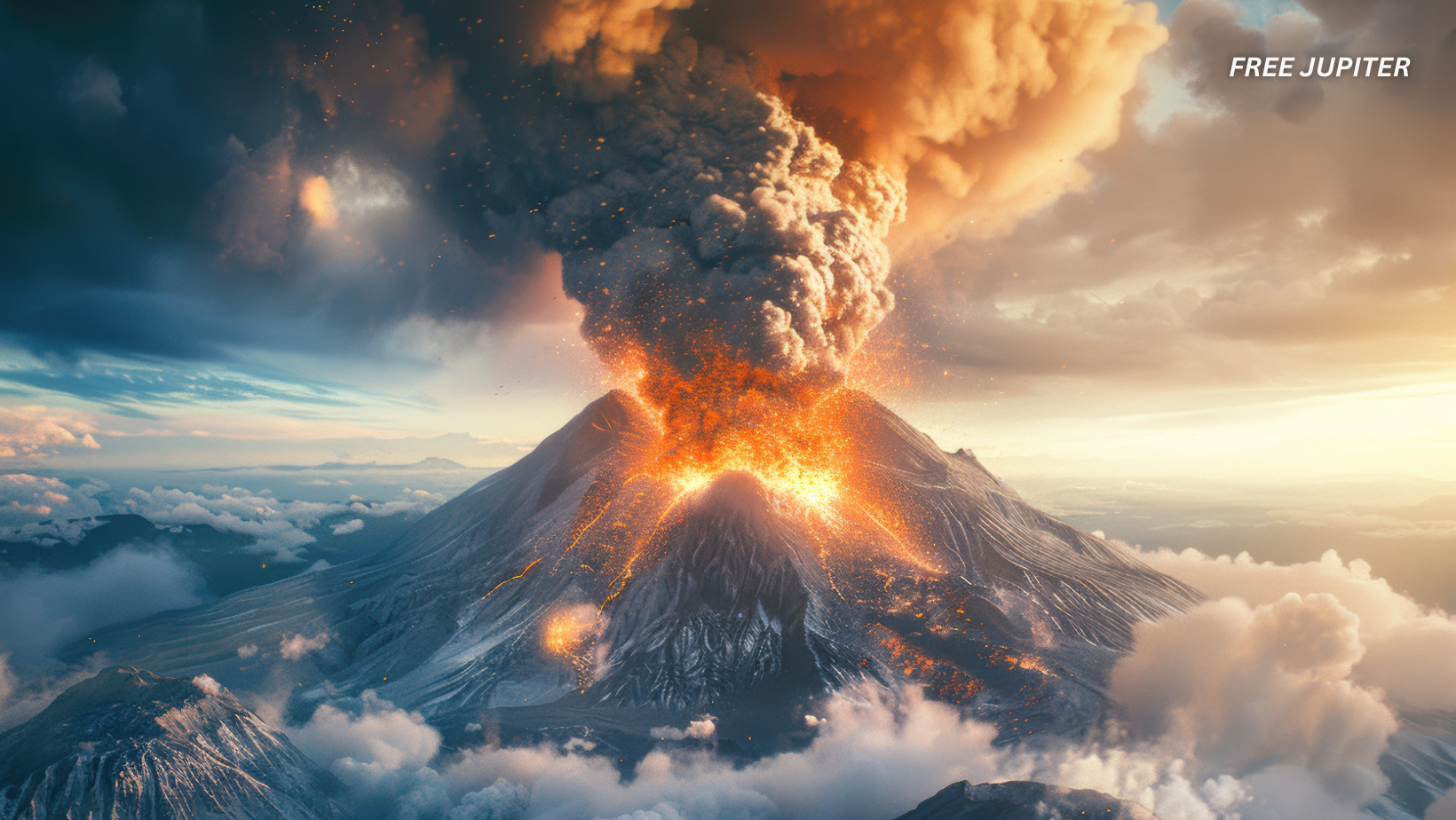Friendly Note: FreeJupiter.com shares general info for curious minds 🌟 Please fact-check all claims—and always check health matters with a professional 💙
Volcanic eruptions have long fascinated humanity—not only for their dramatic displays of nature’s power but also for their profound influence on Earth’s climate system. Recent scientific breakthroughs have uncovered an intriguing role that volcanic ash plays high above us: acting as a catalyst for the formation of ice clouds.
This discovery sheds new light on the complex interplay between volcanic activity and atmospheric processes, with implications for climate science, weather prediction, and our understanding of Earth’s delicate environmental balance.
The Multifaceted Climate Influence of Volcanoes
Volcanoes are often considered agents of destruction, yet their impact on the environment is multifaceted and extends far beyond the immediate vicinity of an eruption. When a volcano erupts, it releases a cocktail of gases and particles into the atmosphere. Among these, carbon dioxide (CO₂) and sulfur dioxide (SO₂) are particularly influential in shaping climate dynamics.
- Carbon Dioxide contributes to the greenhouse effect, trapping heat and potentially warming the planet over long periods.
- Sulfur Dioxide can lead to the formation of sulfate aerosols, tiny particles that reflect sunlight and cool the atmosphere temporarily.
Alongside these gases, volcanic eruptions inject vast quantities of ash and dust into the stratosphere—the layer of the atmosphere where many clouds form. These aerosols can linger for months or even years, influencing atmospheric chemistry and cloud microphysics in ways scientists are only beginning to understand.
The Enigma of Volcanic Aerosols and Cloud Formation
For decades, researchers have grappled with a fundamental question: how do volcanic aerosols affect cloud formation? Clouds are critical components of Earth’s climate system, regulating the planet’s energy balance by reflecting sunlight and trapping heat. They also play a vital role in the water cycle, influencing precipitation and weather patterns.
The challenge lies in understanding the microphysical processes by which aerosols interact with water vapor to form clouds. Specifically, scientists have been curious about the role volcanic ash particles play in the formation of cirrus clouds—thin, wispy clouds composed mainly of ice crystals that form at high altitudes.
Read more: NASA Captures Stunning Image Of Massive Mars Volcano Piercing Through The Ice Cloud Belt
Breakthrough Research from Lawrence Livermore National Laboratory
A team of atmospheric scientists at Lawrence Livermore National Laboratory (LLNL), led by Lin Lin, has made significant strides in unraveling this mystery. By analyzing a rich dataset spanning ten years from NASA’s CloudSat and CALIPSO satellite missions, the researchers observed how volcanic ash influences cirrus cloud formation.
- CloudSat uses radar to penetrate cloud layers, revealing their internal structure and composition.
- CALIPSO employs lidar technology to measure aerosols and cloud particles, providing detailed vertical profiles of the atmosphere.
The team focused on three major volcanic eruptions with varying ash content. They discovered that eruptions rich in ash led to an increase in the frequency of cirrus clouds at high altitudes. Intriguingly, these clouds contained fewer ice crystals than usual, but the crystals were significantly larger.
This finding was unexpected. The prevailing assumption was that volcanic aerosols would increase the number of ice crystals by providing abundant nucleation sites. Instead, the data indicated a more nuanced process: water vapor tended to condense onto ash particles before temperatures dropped low enough for spontaneous ice formation, resulting in fewer but larger ice crystals.
Read more: Scientists Once Drilled So Deep Into the Center of the Earth, They Knocked on the Mantle’s Door
Understanding Ice Nucleation on Volcanic Ash
The process at play here is known as ice nucleation—the initiation of ice crystal formation on particles suspended in the atmosphere. Volcanic ash particles act as “seeds” or nuclei that facilitate the transition of water vapor into ice.
- Normally, ice crystals form when supercooled water droplets freeze spontaneously at very low temperatures.
- In the presence of volcanic ash, water vapor condenses onto the ash particles at higher temperatures than would otherwise be necessary.
- This condensation leads to the growth of larger ice crystals, altering the microphysical properties of cirrus clouds.
Lin Lin emphasizes the significance of this discovery: “Our research overturns previous assumptions about volcanic aerosols and cloud formation. It highlights the complex ways in which volcanic ash can modulate atmospheric processes.”
The Climatic Importance of Cirrus Clouds
Cirrus clouds, despite their delicate appearance, have a substantial impact on Earth’s radiation budget. They are semi-transparent to incoming sunlight but trap outgoing infrared radiation, contributing to a warming effect known as the greenhouse effect.
Changes in cirrus cloud properties—such as crystal size and concentration—can influence how much heat is trapped or reflected, thereby affecting local and global temperatures. Understanding how volcanic ash alters these clouds helps scientists refine climate models, improving predictions of future climate scenarios.
Broader Implications: From Ice Sheets to Atmospheric Feedback Loops
The influence of volcanic activity extends beyond cloud formation. Research from The Earth Institute at Columbia University highlights how volcanic ash impacts ice sheets, particularly during past glacial periods.
- Ash Deposition on Ice: When volcanic ash settles on ice sheets, it darkens their surface, reducing reflectivity (albedo) and causing them to absorb more solar radiation.
- Accelerated Melting: This absorption accelerates melting, which can contribute to sea-level rise and alter regional climate patterns.
- Feedback Mechanisms: Melting ice reduces pressure on Earth’s crust, potentially triggering further volcanic activity—a feedback loop with significant geological and climatic consequences.
These insights underscore the interconnectedness of Earth’s systems, where volcanic eruptions influence not only the atmosphere but also cryospheric and geological processes.
Future Directions and the Quest for Validation
The LLNL team is now applying their findings to study Arctic clouds and their representation in global climate models. The Arctic region is particularly sensitive to climate change, and improved understanding of cloud-aerosol interactions there is critical for accurate forecasting.
Moreover, scientists eagerly await the next major volcanic eruption to test their hypotheses in real time. Each eruption provides a natural laboratory to observe how volcanic ash interacts with atmospheric water vapor under varying conditions.
Read more: Scientists Warn, One of World’s Supervolcanoes is Waking Up: ‘It Will Plunge The Planet Into Chaos’
Concluding Thoughts: Volcanoes as Climate Modulators
Volcanoes are far more than spectacular natural phenomena; they are integral components of Earth’s climate machinery. Their ash clouds serve as unexpected architects of ice clouds, influencing atmospheric chemistry, cloud microphysics, and ultimately, climate patterns.
Thanks to advances in satellite technology and dedicated research efforts, we are beginning to decode these complex processes. This knowledge not only enriches our understanding of Earth’s dynamic systems but also enhances our ability to predict and respond to climate change.
As we continue to explore the skies and the forces that shape them, volcanic eruptions remind us of nature’s intricate balance—a balance in which even the smallest particles can have outsized effects on the world we call home.










